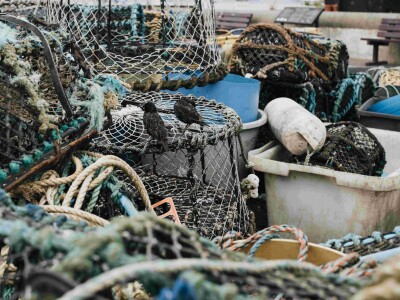Trouble towing
From U.S. Coast Guard reports
A 60-foot wooden shrimper with a crew of three got under way off the coast of South Carolina at 8 a.m. After a full day of fishing, they anchored to take a break for dinner, stow their nets and get ready for a run up a small river to off-load.
Meanwhile, a 57-footer that was fishing nearby had fouled its propeller while hauling back, leaving the boat disabled. At about 5 p.m., the skipper of the disabled boat dropped anchor and made a call for assistance on channel 16. The skipper of the shrimper was familiar with the disabled boat and knew they were headed to the same dock, so he responded to the call and agreed to provide a tow.
The shrimper hauled anchor and made its way toward the disabled boat. Within half an hour, the shrimper and the disabled boat were both under way with 30 feet of towline between them. In order to get into port and reach the seafood dock, the boats would have to pass through a swing bridge that crossed the river. As they neared the swing bridge, the skipper of the shrimper shortened the towline to about 15 feet for better control.
As they made to pass through the opening in the swing bridge, the towline parted. A 10-knot wind was on their backs and the tide was in flood stage running 5 knots toward the swing bridge. The shrimper continued through the swing bridge opening, but the disabled boat was adrift. It struck the north side of the bridge’s fender system, pivoted to starboard and was pinned, starboard side to, on the bridge’s piers. It was around 7:30 p.m., and the bridge operator reported the incident to the county marine rescue unit and fire department and closed the bridge to vehicular traffic.
The shrimper had made it safely through the swing bridge and had turned around to stem the tide and wind. By 8:15 p.m., the skipper of the shrimper had gotten his boat back through the bridge opening, had maneuvered into position and passed another towline to the disabled boat. The skipper of the shrimper tried to pull the disabled boat off and clear of the bridge piers, but was struggling in the wind and current.
Maneuvering near the bridge had become precarious, and the skipper of the shrimper, concerned that his boat would also become entangled in the bridge’s structure, made the decision to remove the towline and await better conditions. He instructed a crewman on deck to cut the towline. As the crewman bent over to cut the line, the large stainless steel cleat, to which the towline was attached, broke free at its base and shot aft. The cleat, still attached to the towline, struck the crewman in the face.
At almost that same moment that the crewman was injured (around 10:30 p.m.) the local marine rescue boat arrived. The crewman’s injuries were evaluated as “needing medical care beyond first aid,” and he was transported to a hospital.
Later that night, the shrimper crew successfully towed the disabled boat to the dock, where a damage assessment was scheduled for the next day.
Lessons learned
The injured crewman was treated for a fractured jaw, severe lacerations to the mouth and to the area above one of his eyes; it was reported that he made a full recovery.
He was lucky. Lines under tension can cause serious injury. When a rope or line parts under tension, it usually snaps back with a corkscrew motion. So don’t stand in the direct line of pull, and stay out of bights of line. Make sure the crew is attuned to their surroundings; listen for warning sounds that indicate excessive strain on deck fittings and lines.
It is essential that crew members be properly trained and supervised while performing dangerous activities. If you decide to assist another fishing vessel, remember that the task must be performed slowly and cautiously. Carefully evaluate risks (including weather and sea conditions) and discuss how the crew will approach a situation before proceeding. Towing — just like operating fishing gear like winches, net reels, deck cranes and hoists — has potential dangers, so it is important to anticipate the problems. In this case, a crew member, acting with a sense of urgency, with his vessel fast approaching the bridge structure, entered a danger zone around a towline under strain. Such haste of action, while perhaps necessary and even laudable in emergency conditions, can result in cutting corners and taking unwarranted risks.
Be careful to use a long enough towline. The shorter the towline, the more strain on the line and the more vulnerable to shock loads caused by alterations to course and speed. Although it is possible to tow by a single pendant/towing hawser (rope, wire or chain), it is better to use bridles. When feasible, don’t secure towing gear directly to deck bitts; it is safer to lead the tow gear through fairleads to bitts and then to secondary fittings.
It was by pure luck that the crewman on deck did not die or suffer a permanent injury. Help make your own luck: Go slow and steady, and fish safe!
This article is based on U.S. Coast Guard reporting and is intended to bring safety issues to the attention of our readers. It is not intended to judge or reach conclusions regarding the ability or capacity of any person, living or dead, or any boat or piece of equipment.








